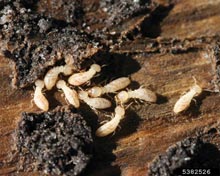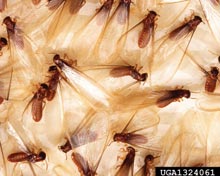
Johnny N. Dell

Scott Bauer, USDA Agricultural Research Service
Subterranean Termites
General Description
Termites are often confused with ants because of their similar appearance. Worker termites are wingless, light
colored, around one-eighth of an inch long, with the abdomen broadly joined to the thorax and the antenna made
up of tiny bead-like segments, not “elbowed” as with ants. Reproductive termites, also known as “swarmers,” are
winged, with all four wings being about the same size and shape (compared to the shorter hind wings of ants).
Most people are familiar with the extensive destruction that termites can cause to wooden structures. Termites
also can damage structural wood in steel and concrete buildings, such as trim or molding, paneling, furring strips,
door and window frames. Stored files, stacked books, or any other cellulose-based material (such as fiberboard
sheathing or insulation panels) also may be attacked. Most termite problems in large buildings involve
subterranean colonies that persist for years on buried wood and constantly explore upwards for new sources
of food. These colonies are often a nuisance not because of the actual damage they cause, but because large
numbers of winged swarmers periodically find their way into occupied spaces.
General Control
Although extremely disruptive, swarmers are harmless, do not bite or carry disease, and cannot damage wood.
Swarming termites should be controlled with a vacuum rather than a space spray, though spraying may be
unavoidable in some circumstances. The arrival of swarming termites should be greeted with a termite inspection
from a pest management professional. Termite damage can become extensive so routine inspections to detect
infestations early is advisable. Once worker termites are found to be feeding inside a structure, the application of
termiticides to the soil around the structure, and/or in bait form, are necessary to protect the structure.









